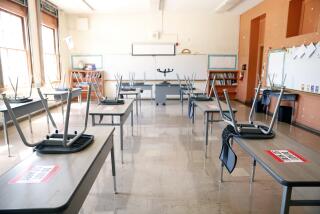DOMESTIC: You Get What You Pay For
- Share via
We’ve been hearing a lot of quick-fix suggestions for improving our schools: more standardized testing, vouchers, privatization. But none of these will produce what our society needs: smart and thoughtful adults.
The key is to reinvent schools in which young people keep company with such adults. To do this, we need to break up the big centralized school buildings and create smaller schools with smaller classes where teachers and principals have the freedom they need to be successful and then held accountable for the results, in other words where grown-ups are expected to act like grown-ups.
Only by surrounding children with adults who are engaged in thoughtful, responsible and intellectually challenging work can we expect the young to do that kind of work, too.
In New York City, where I taught for 30 years, we discovered a way to do this. Right in the midst of the nation’s biggest system, we organized hundreds of small, unique schools. Parents were then free to choose a public school that had the curriculum, faculty and spirit that was best for their child. Parents, students and teachers created communities where they could get to know each other well and work closely toward shared goals. Teachers in such schools are required to exercise intelligence rather than expected to dutifully implement other peoples’ mandates.
Folks around the country who have tried similar reforms have found the same thing: It works. The hard data prove the case; they are not only good for achievement, they’re cost-effective. At our school in East Harlem, more than 90% of our incoming 9th-graders stay in school until graduation, and 90% of our graduates go on to college.
Small schools and small classes cost more per student than big ones; in California, for example, it took several billion dollars to reduce class size in just a few grades. If we allow schools to buy the unique supplies they need to meet their missions, we will have to sacrifice the economies of scale provided when central bureaucracies buy the same unneeded things for everyone. Per graduate, these small, more autonomous schools produce high-quality results at bargain prices.
As we look to reform our schools, we need to remember that we are building on a strong foundation. Many people might be surprised to discover what the mainstream press has been so quiet about: The U.S. is near the top in all international comparisons of basic literacy in fourth grade, second only to Finland, according to a National Center for Education Statistics study reported in Teacher magazine.
Our economy is in good shape in part because we have a good public system of education. We don’t have to scuttle it in favor of experiments with privatization or centralization. The best solutions build upon our past successes.
There is one problem that will require far greater investment: the gap in school achievement between the haves and have-nots. This mirrors the gap that’s always been there and is growing greater as income and other “quality of life” divisions grow apace.
The disadvantages that come with being born poor will take more than just a focus on fixing our schools. Schoolchildren, after all, spend only a fifth of their waking hours in class. Children need the company of well-paid and talented adults during at least part of that other four-fifths of time if they are going to reach their full potential. Parents understand this, and those who can afford it spend thousands of dollars for added instruction for their children in music, athletics, art, etc. Providing similar opportunities for all would be expensive, but it would go far in reducing the gap.
We can improve education if we don’t turn our backs on public schools. Breaking up the big anonymous institutions and creating smaller, independent schools will breathe new life into our classrooms at a price we can afford. Miracles are happening in these small, self-governing schools where powerful grown-ups have a chance to keep company with kids.
More to Read
Sign up for Essential California
The most important California stories and recommendations in your inbox every morning.
You may occasionally receive promotional content from the Los Angeles Times.













